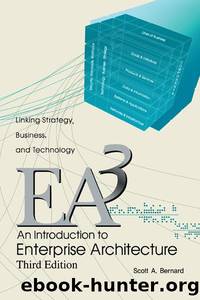An Introduction to Enterprise Architecture: Third Edition by Scott A. Bernard

Author:Scott A. Bernard [Bernard, Scott A.]
Language: eng
Format: mobi
ISBN: 9781477258019
Publisher: AuthorHouse
Published: 2012-08-12T16:00:00+00:00
EA Components:
• Knowledge Warehouses
• Information Systems
• Databases
EA Artifacts:
• Knowledge Management Plan (D-1)
• Information Exchange Matrix (D-2)
• Object State-Transition Diagram (D-3)
• Object Event Sequence Diagram (D-4)
• Logical Data Model (D-5)
• Physical Data Model (D-6)
• Activity/Entity (CRUD) Matrix (D-7)
• Data Dictionary/Object Library (D-8)
Documenting information flows involves the development of data models that show the structure and flow of data in the enterprise’s business services and supporting IT systems/services. Data can be modeled and analyzed using “traditional” and/or “object-oriented” methods, depending on how the resulting documentation is intended to be used. For example, if the intended use is with relational databases and/or third-generation procedural programming languages (i.e., C, FORTRAN, or COBOL) then the use of traditional methods (i.e., Entity-Relationship Diagrams and Data Flow Diagrams) is called for. If the intended use of data is with object-oriented databases, fourth generation object-oriented (OO) programming languages and associated object-oriented diagrams that use the Universal Modeling Language (UML) are called for (e.g.., Java, C++, ADA, and Smalltalk). This OO approach also uses what is called the Common Object Reuse Brokered Architecture (CORBA).
Data Structure and Data Flow Diagrams
Modeling Information Structure. The “traditional” approach to information systems development is based on the modeling technique called Entity Relationship Diagramming (ERD). ERDs are used by IT systems analysts and programmers to identify the “things” (data entities) that an enterprise wants IT systems to capture, as well at those external entities that a system interfaces with. ERDs also provide data entity descriptions, attributes, relationships, and the rules for the frequency of those relationships. In that enterprise architecture seeks to provide an enterprise-wide view of all IT resources, it is important that ERDs show not only what is in each system, but also how systems interface with each other. ERDs are not decomposed per se, but they can serve to show several systems, or parts of large complex systems. Figure 7-5 on the next page shows an example of an ERD diagram for a hypothetical real estate tracking system.
Download
This site does not store any files on its server. We only index and link to content provided by other sites. Please contact the content providers to delete copyright contents if any and email us, we'll remove relevant links or contents immediately.
Hit Refresh by Satya Nadella(8338)
The Compound Effect by Darren Hardy(7557)
Change Your Questions, Change Your Life by Marilee Adams(6641)
Nudge - Improving Decisions about Health, Wealth, and Happiness by Thaler Sunstein(6633)
The Black Swan by Nassim Nicholas Taleb(6190)
Daring Greatly by Brene Brown(5640)
Deep Work by Cal Newport(5463)
Principles: Life and Work by Ray Dalio(5322)
Rich Dad Poor Dad by Robert T. Kiyosaki(5149)
The Myth of the Strong Leader by Archie Brown(4789)
Man-made Catastrophes and Risk Information Concealment by Dmitry Chernov & Didier Sornette(4735)
Big Magic: Creative Living Beyond Fear by Elizabeth Gilbert(4723)
The Slight Edge by Jeff Olson(4722)
Discipline Equals Freedom by Jocko Willink(4635)
Digital Minimalism by Cal Newport;(4540)
The Motivation Myth by Jeff Haden(4524)
Stone's Rules by Roger Stone(4415)
Management Strategies for the Cloud Revolution: How Cloud Computing Is Transforming Business and Why You Can't Afford to Be Left Behind by Charles Babcock(4130)
The Doodle Revolution by Sunni Brown(4042)
